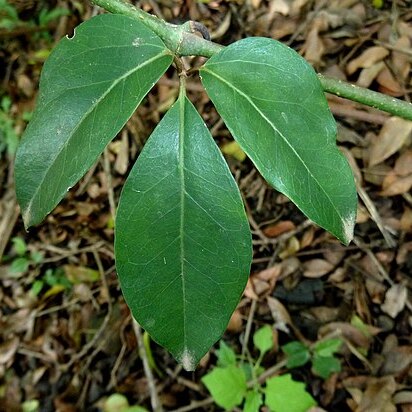Frutex ramosus, parce cirrhosus, gemmis ramulisque extremis pilis rufidulis sericeis indutis caeterum in partibus adultis glaberrimus, foliis petiolatis ternatis, foliolo centrali oblongo basi in petiolulum augustato lateralibus subfalcato-oblongis omnibus obtusis margine leviter revoluto integris rigidis subtus pallidioribus (exsiccatis pallide fulvis), cymis oppositifoliàs breviter pedunculatis paucifloris (floribus in specimine in fructus mutatis), baccis breviter et crasse pedicellatis pisi forma et mole mono-dispermis, semine subgloboso v. si duo adsint semi-globoso undique obtuse rugoso-subtuberculato, rapbe fililormi sæpe excentrica, foveolis faciei chalazaque dorsali obsoletis. Rami adulti lignose, peridermide albida arida vestiti, internodiis bervibus. Foliola 1-3 cent longa.
Leaves 3-foliolate; petioles up to c. 4 cm. long, indumentum as in young stems; stipules not seen; leaflet-lamina up to 12 × 6 cm., terminal leaflets narrowly lanceolate, lanceolate, oblanceolate or ovate, laterals lanceolate, subfalcate-oblong or rhomboid, apex obtuse or acute, margins entire or slightly undulate-lobed on the lateral leaflets, sometimes revolute, base from narrowly to broadly cuneate, from thinly pubescent to glabrous above, from ferruginous-or fulvous-tomentose to glabrous below; axils of main nerves sometimes provided with domatia; petiolules up to 2 cm. long.
A shrub which often scrambles. It can be a small tree. It can grow up to 7 m tall. The bark is grey and scaly. The young parts have woolly hairs. The leaves have 3 leaflets. The leaflets vary in size and shape. They can be narrow to oval to almost square. The upper surface is glossy dark green. The underneath has rusty hairs. The flowers are yellowish-green. The flower stalks have rusty hairs. The flowers are in small dense heads in the axils of leaves. The fruit have 2 lobes. They are 1-1.5 cm across and fleshy. They are black when mature.
Shrub or small tree to 3·3 m. tall with drooping branches or sometimes with sarmentose branches or more rarely a climber; young branches appressed-ferruginous-pubescent or densely fulvous-or ferruginous-pubescent or-tomentose, later glabrescent; tendrils tomentose, pubescent or glabrescent, often absent in herbarium specimens.
Shrub, creeper or small tree, up to 3 m high. Leaves 3-foliolate, leaflet lamina up to 120 x 60 mm, terminal leaflets narrowly lanceolate, lanceolate, oblanceolate or ovate, lateral leaflets lanceolate, subfalcate-oblong or rhomboid. Flowers yellowish green.
Inflorescences of rather lax or moderately dense cymes, branches from appressed-ferruginous-pubescent to fulvous-or ferruginous-tomentose; peduncle up to c. 4 cm. long; pedicels c. 1 mm. long; bracts up to 2 mm. long, lanceolate to ovate, very caducous.
Seeds 1–2, c. 5–7 mm. in diam., subglobose with a flattened side when seeds paired, rugose, with a shallow but distinct longitudinal furrow.
Calyx densely ferruginous-pubescent to fulvous-or ferruginous-tomentose.
Fruit ± black when ripe, 1–1·5 cm. in diam., globose, glabrous.
Flexible porous stems containing copious watery sap
Petals glabrous or with hairs near the apex.
A scrambling shrub or large climber
Flowers brownish
Fruits black


